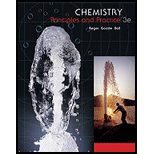
Concept explainers
(a)
Interpretation:
The percentage by mass of each element in
(a)
Explanation of Solution
First the molar mass of
Thus one mole of
(b)
Interpretation:
The percentage by mass of each element in
(b)
Explanation of Solution
First the molar mass of
Thus one mole of
(c)
Interpretation:
The percentage by mass of each element in
(c)
Explanation of Solution
First the molar mass of
Thus one mole of
Want to see more full solutions like this?
Chapter 3 Solutions
Chemistry
- Nitrogen fixation in the root nodules of peas and other legumes occurs with a reaction involving a molybdenum-containing enzyme named nitrogenase. This enzyme contains two Mo atoms per molecule and is 0.0872% Mo by mass. Calculate the molar mass of the enzyme.arrow_forward4.44 Industrial production of hydrogen gas uses the reaction shown below. If 1.00 metric ton of propane reacting with excess water yields 270 kg of H2, what is the percentage yield? C3H8(g)+3H2O(l)3CO(g)+7H2(g)arrow_forwardWhich molecule has a molecular mass of 28.05 amu?arrow_forward
- How many moles of beryllium (Be) are needed to completely react with 10.0 moles of N2 in the synthesis of the compound Be3N2?arrow_forwardThe structure of one of the bases in DNA, adenine, is shown here. Which represents the greater mass: 40.0 g of adenine or 3.0 1023 molecules of the compound?arrow_forwardThe active ingredient in Pepto-Bismo® (an over- the-counter remedy for an upset stomach) is bismuth sub-salicylate, C7H5BiO4. Analysis of a 1.7500-g sample of Pepto-Bismol yields 346 mg of bismuth. What percent by mass is bismuth subsalicylate in the sample? (Assume that there are no other bismuth-containing compounds in Pepto-Bismol.)arrow_forward
- Consider the hypothetical reaction 8A2B3(s)+3X4(g)4A4X3(s)+12B2(g)When 10.0 g of A2B3(MM=225g/mol) react with an excess of X4, 4.00 g of A4X3 are produced. (a) How many moles of A4X3 are produced? (b) What is the molar mass of A4X3?arrow_forward3.51 Modern instruments can measure a mass as small as 5 nano- grams. If one observed 5.0 ng of CO2, how many molecules were measured?arrow_forward4.45 If 21 g of H2S is mixed with 38 g of O2 and 31 g of SO2 forms, what is the percentage yield? 2H2S+3O22SO2+2H2Oarrow_forward
- One of the hydrates of Na2CO3 is sodium carbonate decahydrate A 55.6 gram sample of Na2CO3 10 H2O was heated thoroughly in a porcelain crucible, until its weight remained constant. After heating, how many grams of the anhydrous compound remained?arrow_forwardThe approximate minimum daily dietary requirement of the amino acid leucine, C6H13NO2, is 1.1 g. What is this requirement in moles?arrow_forward(a) What is the chemical formula of eugenol, the main contri butor to the aroma of cloves? (b) Calculate its molar mass. (c) How many moles are contained in 10.50 g of eugenol?arrow_forward
 Chemistry & Chemical ReactivityChemistryISBN:9781337399074Author:John C. Kotz, Paul M. Treichel, John Townsend, David TreichelPublisher:Cengage Learning
Chemistry & Chemical ReactivityChemistryISBN:9781337399074Author:John C. Kotz, Paul M. Treichel, John Townsend, David TreichelPublisher:Cengage Learning Chemistry for Engineering StudentsChemistryISBN:9781337398909Author:Lawrence S. Brown, Tom HolmePublisher:Cengage Learning
Chemistry for Engineering StudentsChemistryISBN:9781337398909Author:Lawrence S. Brown, Tom HolmePublisher:Cengage Learning Chemistry & Chemical ReactivityChemistryISBN:9781133949640Author:John C. Kotz, Paul M. Treichel, John Townsend, David TreichelPublisher:Cengage Learning
Chemistry & Chemical ReactivityChemistryISBN:9781133949640Author:John C. Kotz, Paul M. Treichel, John Townsend, David TreichelPublisher:Cengage Learning General, Organic, and Biological ChemistryChemistryISBN:9781285853918Author:H. Stephen StokerPublisher:Cengage Learning
General, Organic, and Biological ChemistryChemistryISBN:9781285853918Author:H. Stephen StokerPublisher:Cengage Learning Chemistry: Principles and PracticeChemistryISBN:9780534420123Author:Daniel L. Reger, Scott R. Goode, David W. Ball, Edward MercerPublisher:Cengage Learning
Chemistry: Principles and PracticeChemistryISBN:9780534420123Author:Daniel L. Reger, Scott R. Goode, David W. Ball, Edward MercerPublisher:Cengage Learning Chemistry by OpenStax (2015-05-04)ChemistryISBN:9781938168390Author:Klaus Theopold, Richard H Langley, Paul Flowers, William R. Robinson, Mark BlaserPublisher:OpenStax
Chemistry by OpenStax (2015-05-04)ChemistryISBN:9781938168390Author:Klaus Theopold, Richard H Langley, Paul Flowers, William R. Robinson, Mark BlaserPublisher:OpenStax





